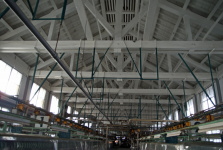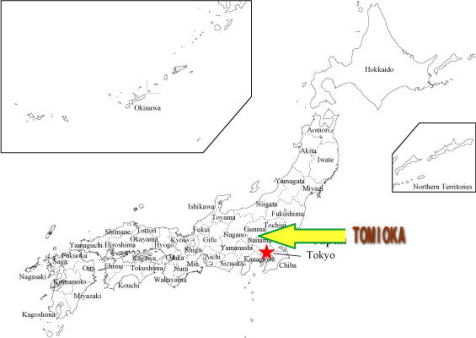World Heritage in Japan 18
The Tomioka Silk Mill and Related Industrial Heritage
The Tomioka Silk Mill and Related Industrial Heritage (Culture, registered in 2014)
The Tomioka Silk Mill was built in 1872 by Meiji Government as a model
silk-reeling factory to industrialize Japan. They made it in Tomioka because
sericulture had been active in Tomioka as well as the resourses such as
water and coal. French engineer Paul Brunat was hired and introduced French
reeling machines. Factory was open to the public to show what the modern
industry was. Female workers were recruited from all over Japan and after
leaning the technique, they went back to their home town and introduced
the technology at the local factory.
Tomioka Silk Mill and related industrial heritage are listed as world cultural
heritage because of their contribution to modernaization of Japan and international
exchange and innovation of technology in the silk industry.
The Tomioka Silk Mill
It was listed as world cultural heritage because "Japan's first full-scale silk mill introducing French technology", "Typical factory construction combining Japanese and Western technology" as well as the contribution to the development of filature and sericulture technology.
Silk reeling mill, 140.4m x 12.3m, made in half-timbered brick style, is
the central building. The factory with 300 reeling machines was the world
biggest at that time. To make inside bright, French large glass was used.
The hight of the table was adjusted with the hight of the Japanese female
workers. The machine had changed byt the time, but because the factory
building was big enough, they didn't have to expand the building. In this
way, the original building has remained. They continued the operation until
1987.
Two silk storage buildings have 104.4m x 12.3m and made with half-timbered brick style. When they started the operation, they bred the silkworm only once a year in spring, they needed a huge storage. They could store 32 tons of silk cocoon in two buildings. They used second floor for storage because of the ventilation.
Also, Steam pan factory, Brunat House, Dormitory for French femal instructors,
Dormitory for French male engineers, existing oldest iron construction,
sewage and drain are remaining.
Former Tajima Yhei's House
This farmhouse used for sericulture was built in 1863 by Tajima Yahei who invented the modern sericultural technique called Seiryoiku featuring ventilation. This structure became a prototype for modern sericulture farmhouse by his books.
Takayamasha, sericulture school
Takayama Chogoro invented the modern sericultural technique called Seioniku,
featuring ventilation and temperature control. In 1884, Takayamasha was
established as a specialized school for sericulture and successfully spread
modern technology throughout Japan and overseas. This method became the
standard for modern sericultural technology. The mainhouse built in 1891
was the ideal farmhouse for the Seioniku method and many people came to
learn.
Arafune Cold Storage
The facility composed with three sections was built in 1905-1914. It was
a cold storage for silkworm eggs using cold air blowing from underground
through gaps between rocks. By the temperature control, multiple rearing
cycles of silkworm was enabled, that was usually carried out once a year
until then. It was one of the biggest storage in Japan.
(Reference: website of Tomioka Silk Mill and Guma Prefecture)
How to access from Tokyo to Tomioka Silk Mill (example)
Tokyo Station-(Shinkansen)-Takasaki Station-(JR)-Joshu-Tomioka Station
About 1km (15 minutes) walk from Joshu-Tomioka Station
Total time: About 2 hours

|
|

Tomioka Silk Mill
 Top page Top page
 General information of Japan General information of Japan
 World heritage in Japan World heritage in Japan
-Horyuji Temple
-Himeji Castle
-Yaku Island
-Shirakami Mountain Range
-Ancient Kyoto
-Shirakawa-go and Gokayama
-Hiroshima Peace Memorial
-Itsukushima Shrine
-Ancient Nara
-Shrines and Temples in Nikko
-Kingdom of Ryukyu
-Kii Mountain Range
-Shiretoko
-Iwami Silver Mine
-Ogasawara Islands
-Hiraizumi
-Mount Fuji
-Tomioka
-Site of Industrial Revolution
-Architectural Work of Le Corbusier
-Okinoshima & Munakata
 Accommodation in Japan Accommodation in Japan
 Japanese food Japanese food
 Japanese culture (National Treasures) Japanese culture (National Treasures)
 Japanese culture 2 (Culture in everyday life) Japanese culture 2 (Culture in everyday life)
 Japanese sports Japanese sports
 Japanese religion Japanese religion
 Souvenir of Japan Souvenir of Japan
 continually updated ! continually updated !
 Travel Diary in Tokyo Travel Diary in Tokyo
 My profile My profile
 Link Link
 English Guiding Service English Guiding Service
 info@ltij.net
info@ltij.net
|


